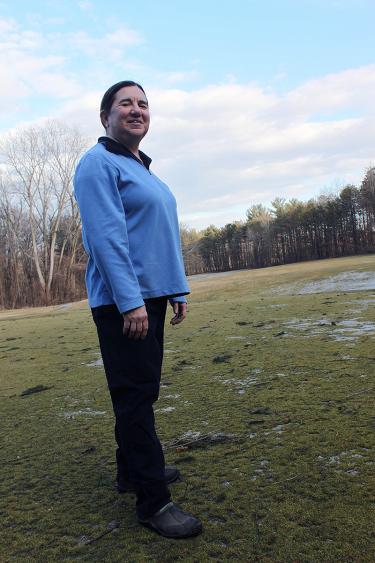Two of Guilderland’s six golf courses closing
GUILDERLAND — In an era when golfers are aging and golfing in the United States is declining, two of the six golf courses in Guilderland are either closed or planning to close. The owners of both French’s Hollow Fairways Golf Course and Hiawatha Trails Executive Golf Course said this week that the decision to close was driven by economics.
“I thought I would never leave this house. I thought I would do this for the rest of my life, but it’s not economically feasible any more,” said Geoffrey Van Epps, owner of Hiawatha Trails Executive Golf Course on Route 155 in Guilderland.
The property on which Hiawatha Trails is located is in the process of being sold; a developer is before the town, seeking approval for a planned unit development that would allow for building four-story apartments and an office building.
Van Epps said this week that his course is open now and will remain open until the deal goes through. He has run the business for over 20 years, since 1996, although the golf course was established in 1958.
He and his wife, Michelle Van Epps, raised their children on the property and still live there, but will also need to move when the sale is completed.
French’s Hollow Fairways golf course, a family business that started 46 years ago, will not open this year, said Janet Betlejeski who owns the property with her sister, Mary. They realized at the end of the last season that they weren’t going to open it up again, but took some time to process that idea, Janet Betlejeski said.
French’s Hollow Fairways was originally a dairy farm and apple orchard farmed by Janet Betlejeski’s grandfather. In 1971, her father, Dr. John Betlejeski, turned it into a golf course, even though he did not golf. Neither do his daughters, who took over running of the course after his death in 1991.
“It was very different,” back then, Betlejeski said of their earlier years. “There were country clubs back then but also room for golf courses like ours that were not as manicured and that didn’t use as many pesticides.”

French’s Hollow Fairways has been in decline, she said, since about 2008 and the start of the economic downturn.
Their course, which had holes ranging from par 3 to par 5, was “very low-key,” Betlejeski said. They charged seniors $13 to play all day. “We were kind of in competition with the town,” she said. “We had very low rates, and they were also lowering their rates, I think to try to get some of the seniors that we were catering to.”
The town of Guilderland had purchased the Western Turnpike Golf Club property — 290 acres with 27 holes — in 2004.
The sisters have no plans for what to do with the land, Betlejeski said. “We’re going to let it go fallow for a while. We’re thinking about trying to get a conservation easement for the property, which will restrict development on it.”
“What’s happening,” said Van Epps, “is that these older generations are aging out, and millennials and gen-Xers don’t play golf.”
He estimated the age of most customers over the years as “45 and up.”
He has tried to bring in younger golfers, offering lessons for adult beginners. He only had a handful of takers for those, he said. He has tried print and television advertising in the past.
Van Epps compared golf to farming. “It’s a seasonal business,” he said, “and you have five months, really, to make it.” His course does remain open in the off-season, with discounted prices. Several people were playing there when he spoke with The Enterprise on Feb. 20, an unseasonably warm day.
Last year, he said, it rained almost every day for more than three months, starting in April.

“I thought I would never leave this house,” said Geoffrey Van Epps, owner of Hiawatha Trails Executive Golf Course. His house, in the center of the frame, will be torn down to make way for a senior independent-living apartment complex, if a proposal is approved, as will the golf course’s clubhouse, at left.
In the past, he said, golfers were tougher, and would come out in a light rain. Nowadays, if the weather forecast is for rain, people make other plans, even if the rain never materializes, Van Epps said. The grounds still need to be maintained, even when no revenue is coming in, he said.
Equipment is expensive, he said, citing $90,000 as the cost for a new fairways mower, and $35,000 for a greens mower.
“Then you also have to pay taxes on top of that,” Van Epps said. By way of comparison, he said, referring to Western Turnpike Golf Course, “The town course gets to buy equipment on the upstate contract, and then they don’t pay any taxes.”
He also has to pay liability insurance, workers’ compensation, and disability.
Hiawatha Trails has no membership program, Van Epps said. It’s a public course, walk-up-and-play, he said; you can make a tee time.
The cost of playing 18 holes, he said, is $16 per person on weekdays and $20 on weekends during the spring and summer. In the off-season, it’s $10 per person. “There are a few people out there today,” he said Tuesday, which was wet but warm.
There are four par-4 holes, and the rest are par 3, he said. “People who play this course regularly get better at their short game, and have fun,” he added. “The short game is really what golf is all about.”
It isn’t just golf, said Van Epps, who is 52. Other sports like bowling or skiing are also suffering, he said. Younger people, he said, “are on their computers and cell phones and don’t get outside and recreate.”
League play was “our bread-and-butter,” Van Epps said. “Nobody’s in leagues any more.”
People would join leagues and play five nights a week. “You couldn’t get a parking spot,” he said at Hiawatha Trails or Western Turnpike, he said.
For a few years, there was a “Tiger boom,” Van Epps said, when new golfers, inspired by watching Tiger Woods play, bought clubs and began playing casually.
Van Epps has a clubhouse, where he offers light fare. “Hamburgers, hot dogs, things like that,” he said.
Van Epps runs the course with his children, who have grown up there. The oldest is now 24. His children have served as counselors at the summer camps he has run for 18 years, which focus on unstructured play.
Too many demands may drive kids away from golf, he says. “Who cares if they hit it forward or backward, as long as no one gets hurt?” Many children who have attended his camps have gone on to play on varsity teams, he said.
He has many “wonderful seniors” who have helped out in the clubhouse, Van Epps said. Their schedule is constant week-to-week, and some golfers come in on certain days when they know they will be able to chat with a particular clubhouse staffer for 15 minutes or so before going out to golf. “That’s what people like,” he said.
He plans to open this spring and has no idea when the course will close, since that will depend on project approval. Van Epps likes to keep busy and says he will probably either buy another business or start another business. He has always been an entrepreneur; years ago, he ran a limousine service, he said.
He has been approached by another business about running a golf course.
Orchard Creek
Four golf courses remain in town. The two country clubs, Pinehaven and Albany — both feature swimming pools and dining venues and have membership fees — did not return calls. One of the other two, Orchard Creek, is privately run, while the fourth, Western Turnpike, is owned by the town of Guilderland.
Orchard Creek Golf Club is owned by Abbruzzese family, which also owns and operates, partly on the same land, Altamont Orchards and the Cider House restaurant at the clubhouse, which is also open to the non-golfing public. Their event business hosts weddings, class reunions, and private parties.
The Abbruzzeses also have a farm market and offer some apple picking. “We’re not as big in the apple business as we used to be,” said John Abbruzzese, who runs the family’s restaurant.
The different businesses that the family runs help support one another, he said.
“Golf is kind of stagnant,” John Abbruzzese said, “but we’re doing great. Between our golf businesses and our wedding business and the restaurant, we’re doing fine.”
His brother, Dan Abbruzzese, who runs the golf course, gave insights into how the business of golf is doing at Orchard Creek.
Dan Abbruzzese described Orchard Creek as a PGA championship 18-hole golf course. It has been ranked, he said, four-and-a-half out of five stars by Golf Digest. “There are only 15 or 18 in the state that are ranked that high,” he said.
It’s a beautiful course, he said, professionally designed by well-known golf-course architect Paul Cowley, son of the late artist from Altamont, Ed Cowley, and his wife, Bette.
Orchard Creek doesn’t do a lot of advertising, he said. “A lot of it is word-of-mouth.” He does go to golf shows and collect email addresses there and send out targeted email blasts to 8,000 to 10,000 people, offering specials including discounted rates for first-time golfers.
Orchard Creek has just hired a new golf professional, Jeff Betti, who will start in April and who has a lot of ideas about reaching more potential golfers and especially younger people, Dan Abbruzzese said.
“As baby boomers are getting older — we’re the ones playing golf — but, once we go, then there could be problems.”
Rates vary by day and time, but the highest rate that Orchard Creek charges is $65, per person, with a golf cart, for the earliest tee times on a weekend morning, he said.
Some people who play often take out memberships, which can significantly reduce the price. “I’ve got guys who play like 120 times a year, and are doing it for like $15 a time,” said Dan Abbruzzese.
Western Turnpike
This town-owned and -operated 27-hole course is open to the public, said Gregory Wier, the director of the town’s parks and recreation department. It isn’t necessary, Wier said, to be a member to play or to take lessons from the director of golf, Herb Moreland, or the golf professional, Casey Childs, both of whom are PGA professionals.
“Obviously,” Wier said, “the town doesn’t pay any property taxes, since the town owns the land.”
Wier said that it can be cost-efficient, for the taxpayers, for the town to make purchases of equipment through state contracts or by putting them out to bid.
The clubhouse at the golf course is owned by the town and leased to the Mallozzi family, Wier said, which pays the town a set fee per year to operate the clubhouse. According to the contract, the Mallozzi organization must provide food to the golfers. The clubhouse also hosts weddings and private parties.
Mallozzi’s pays $12,500 per month for six months each year, for an annual total of $75,000, according to town Clerk Jean Cataldo.
Western Turnpike’s golf pro, Casey Childs, told The Enterprise about several trends he notices there.
One, he said, is that golfers who used to play three or four times a week are not playing as often recently; they now play just once or twice a week, he said. He isn’t sure of the reason, but said, “Time is limited, money is limited, and the weather plays a factor as well.”
This trend is in line with a national pattern that, he said, the PGA “has tried to figure out.”
The other is a “good uptick” over the last five or so years in junior golfers at Western Turnpike — “not just the under 20, but the 22 to 30. We’re crossing our fingers that that will continue, because you need the younger generation.”
The course has 27 holes, with three different 9-holes, which Childs said allows for “more leeway.” It includes par 3, par 4, and par 6 holes. “We’re not considered a shorter course,” he said, noting that the only difference between Western Turnpike and a PGA championship course is length — at a championship course, he said, each hole might be 50 yards longer.
Western Turnpike has increased its membership, Childs said, and has added several leagues and outings.
The golf course “tries to stay in front of things,” Childs says, and is in the process of adding online tee times to its website. That way, Childs said, if someone’s schedule for the following day opens up at 10 p.m., for instance, he or she can go to the website, even though the office is closed, and make a reservation for the next morning.
Golf nationally
Nationally, the numbers of people playing golf on golf courses showed a modest decline in 2016, falling about 1 percent from the previous year, to 23.8 million, according to figures from the National Golf Foundation.
The total number of participants playing traditional green-grass golf has seen a gradual decline in recent years, the report says. It notes that the percentage of “committed golfers” is the highest it has been since 2011 and that “off-course participation” including at driving ranges, Topgolf facilities, and indoor golf simulators was up 11 percent from 2015.
Men make up 75 percent of golfers, and women 25 percent, the report says. Thirty-two percent of golfers are aged 40 and older.
The number of rounds played in 2016 was 469 million. Sixty-nine percent of those were played by people aged 40 or older.
Eight percent were played by men, and 20 percent by women. Fifty-nine percent were played by college graduates, and 29 percent by people earning $125,000 or more per year.
According to a report on the state of golf around the world issued by The Royal and Ancient Golf Club in the United Kingdom, the United States has, since the early 2000s, been experiencing a gradual but steady market correction, due to an oversupply of golf courses.



